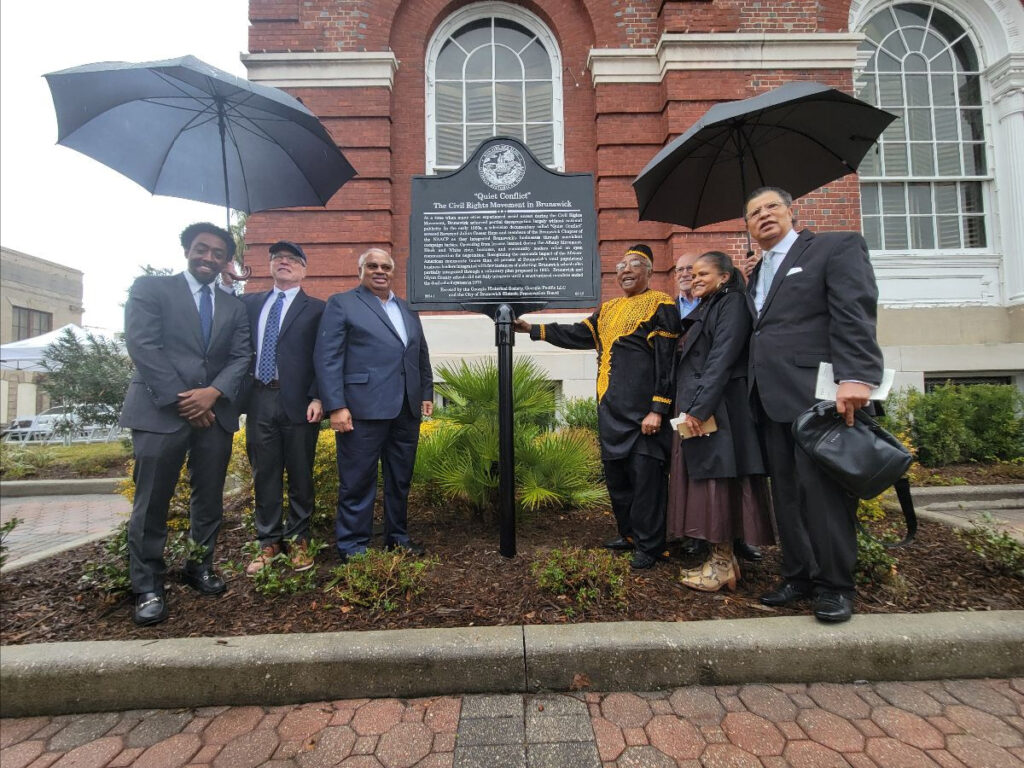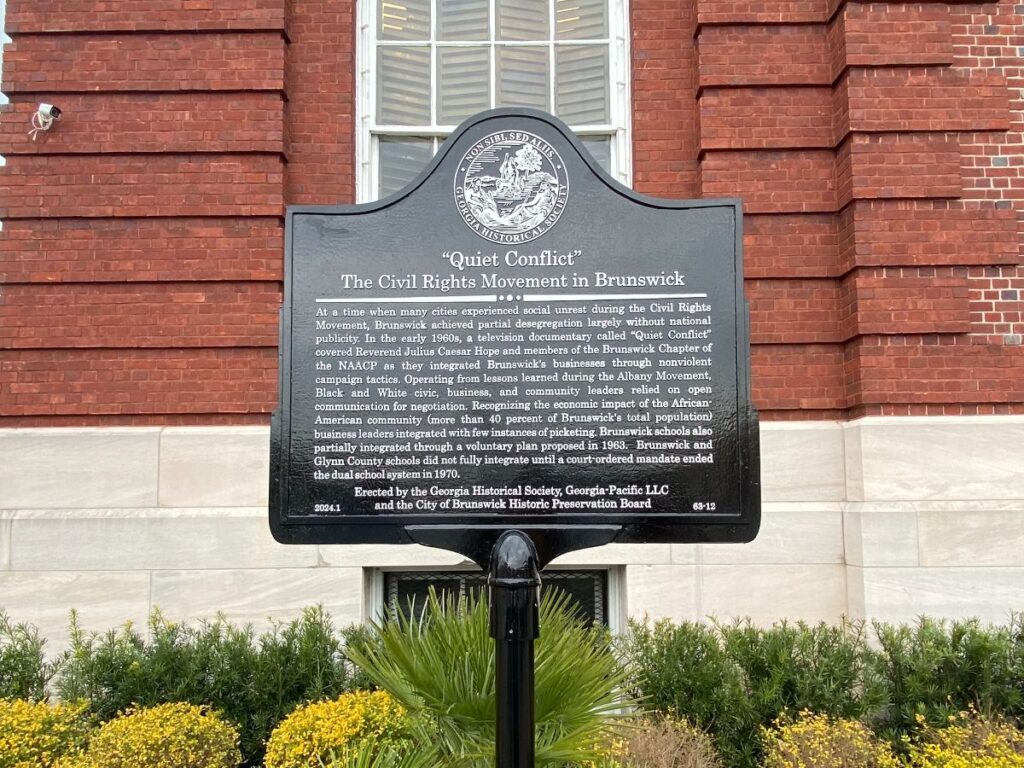
Brunswick, GA, February 23, 2024 — The Georgia Historical Society (GHS) unveiled a new Georgia Civil Rights Trail historical marker recognizing the “Quiet Conflict,” a nickname given by documentary filmmakers to the 1960s desegregation efforts in Brunswick. On Friday, February 23, 2024, GHS dedicated the new marker in partnership with Georgia-Pacific, LLC, and the City of Brunswick Historic Preservation Board.
The marker joins over 50 historical markers across the state that constitute GHS’s Georgia Civil Rights Trail, an initiative that uses historical markers to document the struggle for human and civil rights from the period following Reconstruction to the modern movement in the mid-twentieth century.
“The Georgia Historical Society is pleased to partner with Georgia-Pacific to erect a new historical marker that brings attention to the struggle for civil rights in Brunswick during the 1960s and 1970s,” said Elyse Butler, Manager of Programs and Special Projects, Georgia Historical Society. “With support from community leaders and the City of Brunswick Historic Preservation Board, we are now able to highlight what was once called the ‘Quiet Conflict,’ and illustrate how Brunswick’s African-American community used the power of economics to integrate Brunswick businesses.”
Following the passage of the Civil Rights Act in 1964, White leaders in many Southern communities resisted the legislation prohibiting segregation and discrimination based on race, sometimes with violent confrontations. Brunswick made national headlines in early 1965 as it achieved partial desegregation largely without violence and publicity. The documentary, “Quiet Conflict,” covered the city’s integration, highlighting the reliance on nonviolent tactics and communication during negotiation among community members.
"Atlanta is the bedrock of the Civil Rights Movement and Georgia-Pacific, headquartered in Atlanta, has always been engaged in initiatives that impact societal change here in the state of Georgia and across our footprint," said Curley M. Dossman, Jr., President, Georgia-Pacific Community Affairs and Vice President and General Manager, Koch Companies Community Fund for Koch Industries, the parent company of Georgia-Pacific. "Education is one of our four key investment pillars, and we are proud to recognize Brunswick, Georgia, with this historical marker, in collaboration with our longstanding partner, the Georgia Historical Society. The marker recognizing the desegregation efforts in Brunswick during the ‘Quiet Conflict’ era depicts the shared values between Georgia-Pacific, the Georgia Historical Society, and the City of Brunswick Historic Preservation Board."
“Brunswick Cellulose has been woven into the fabric of our area’s history for the 85 years we’ve been in operation,” said Jack Perrett, Vice President and General Manager, Brunswick Cellulose Plant. “Our workforce of 600 people reflects the power and promise of diversity. On behalf of all our employees and customers who represent many different backgrounds and cultures, I thank the Georgia Historical Society for thoughtfully honoring this period in our past. Those involved in the ‘Quiet Conflict’ made it possible for us in the present to live and work in a diverse and dynamic community.”
The marker dedication took place at Brunswick City Hall. Speakers included Dr. W. Todd Groce, President and CEO, GHS; Crosby Johnson, Mayor, City of Brunswick; Curley M. Dossman, Jr., President, Georgia-Pacific Community Affairs and Vice President and General Manager, Koch Companies Community Fund for Koch Industries; Jack Perrett, Vice President and General Manager, Brunswick Cellulose Plant; Tanya Hope, daughter of Reverend Julius Caesar Hope; Minister Julius Hope, son of Rev. Hope; and Robert Griffin, Brunswick Community Leader.

The marker text reads:
“Quiet Conflict”
The Civil Rights Movement in Brunswick
At a time when many cities experienced social unrest during the Civil Rights Movement, Brunswick achieved partial desegregation largely without national publicity. In the early 1960s, a television documentary called “Quiet Conflict” covered Reverend Julius Caesar Hope and members of the Brunswick Chapter of the NAACP as they integrated Brunswick’s businesses through nonviolent campaign tactics. Operating from lessons learned during the Albany Movement, Black and White civic, business, and community leaders relied on open communication for negotiation. Recognizing the economic impact of the African-American community (more than 40 percent of Brunswick’s total population), business leaders integrated with few instances of picketing. Brunswick schools also partially integrated through a voluntary plan proposed in 1963. Brunswick and Glynn County schools did not fully integrate until a court-ordered mandate ended the dual school system in 1970.
Erected by the Georgia Historical Society, Georgia-Pacific LLC,
and the City of Brunswick Historic Preservation Board
For more information about the “Quiet Conflict” - The Civil Rights Movement in Brunswick historical marker dedication or the Georgia Historical Society marker program, please contact Keith Strigaro, Director of Communications, at 912.651.2125, ext. 153, or by email at kstrigaro@georgiahistory.com.
###
ABOUT THE GEORGIA HISTORICAL SOCIETY
The Georgia Historical Society (GHS) is the premier independent statewide institution responsible for collecting, examining, and teaching Georgia history. GHS houses the oldest and most distinguished collection of materials related exclusively to Georgia history in the nation.
To learn more visit georgiahistory.com.
ABOUT GEORGIA-PACIFIC
Based in Atlanta, Georgia-Pacific and its subsidiaries are among the world's leading manufacturers and marketers of bath tissue, paper towels and napkins, tableware, paper-based packaging, cellulose, specialty fibers, and building products. Our familiar consumer brands include Quilted Northern®, Angel Soft®, Brawny®, Dixie®, enMotion®, Sparkle®, and Vanity Fair®. Georgia-Pacific has long been a leading supplier of building products to lumber and building materials dealers and large do-it-yourself warehouse retailers. Its Georgia-Pacific Recycling subsidiary is among the world's largest traders of paper, metal and plastics. The company operates more than 150 facilities and employs approximately 30,000 people directly and creates more than 80,000 jobs indirectly.
For more information, visit: gp.com/about-us. For news, visit: news.gp.com.
ABOUT THE GEORGIA HISTORICAL MARKER PROGRAM
The Georgia Historical Marker Program is an important part of the Georgia Historical Society’s (GHS) statewide educational mission. Through a public-private partnership with the State of Georgia, GHS is responsible for erecting new historical markers and maintaining more than 2,000 markers installed by the State prior to the program’s privatization in 1998. Online mapping tools allow users to explore themed marker trails and design custom driving routes. Visit georgiahistory.com for more ways to use Georgia’s historical markers and experience history where it happened.
ABOUT THE GEORGIA CIVIL RIGHTS TRAIL
As part of the ongoing work of the Georgia Historical Marker Program to recognize the rich diversity of our state’s past, GHS’s Georgia Civil Rights Trail (CRT) initiative focuses broadly on the economic, social, political and cultural history of the Civil Rights Movement. Recognizing that the struggle for civil and human rights began long before the mid-twentieth-century Movement, the Civil Rights Trail includes historical markers that explore stories from Reconstruction through the late twentieth century.
